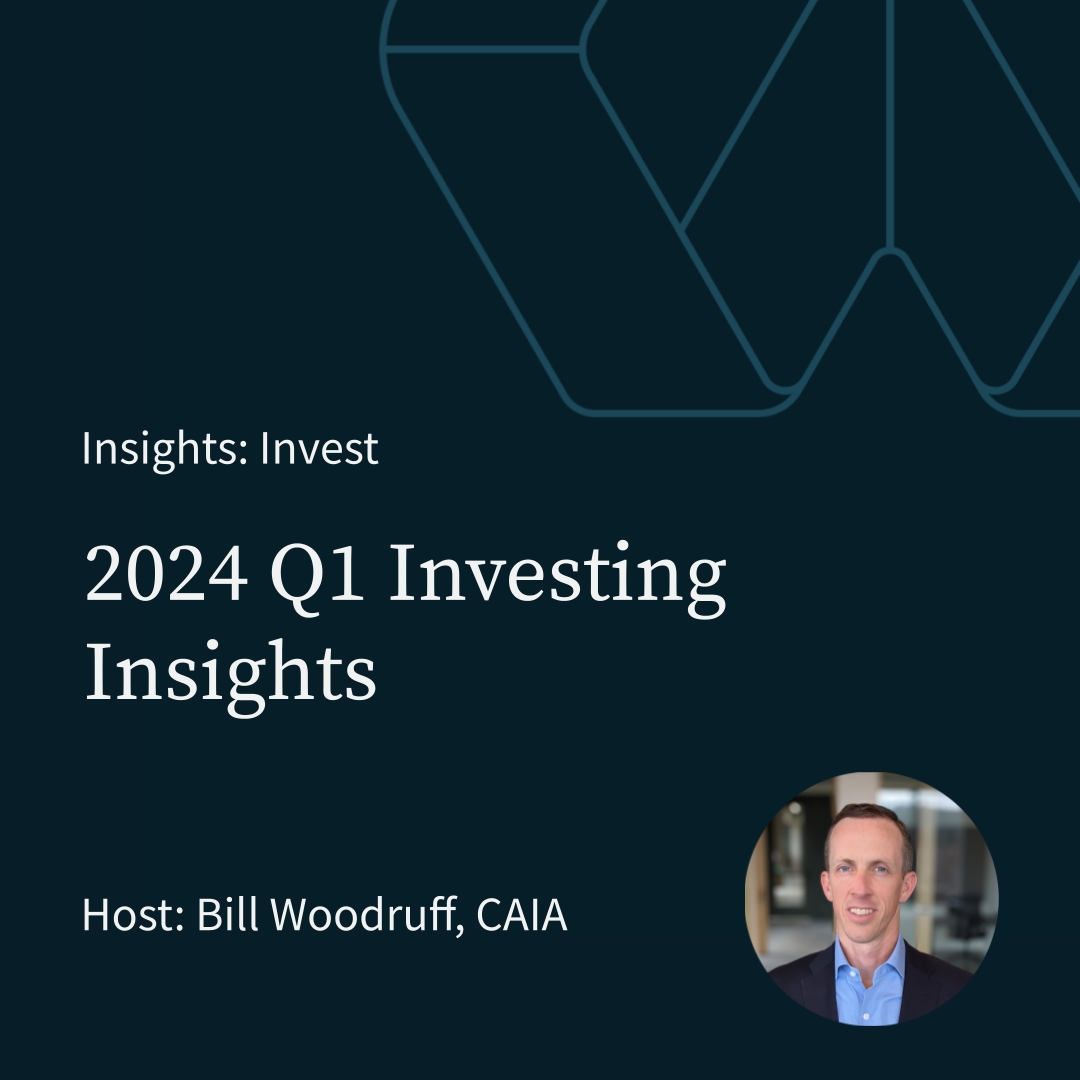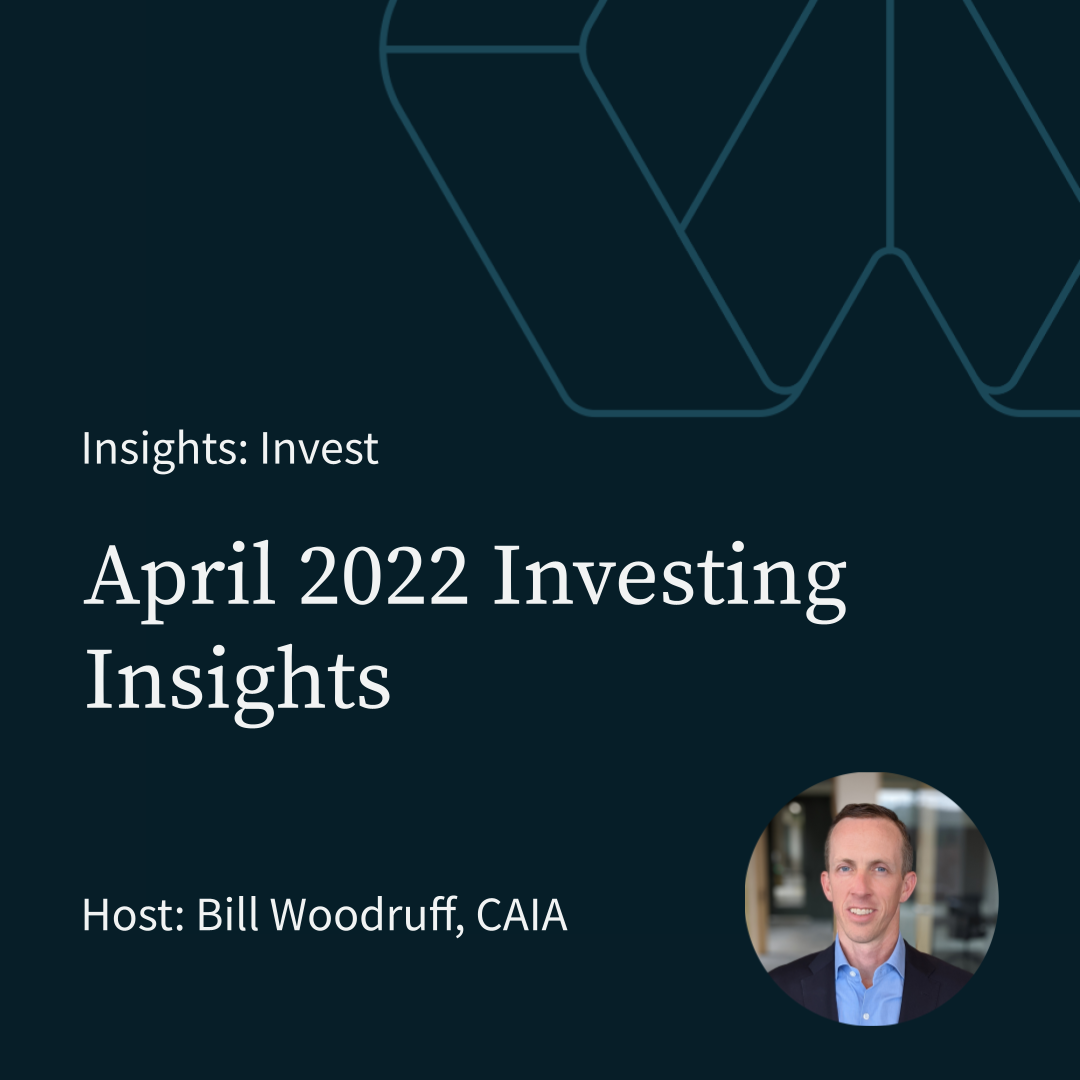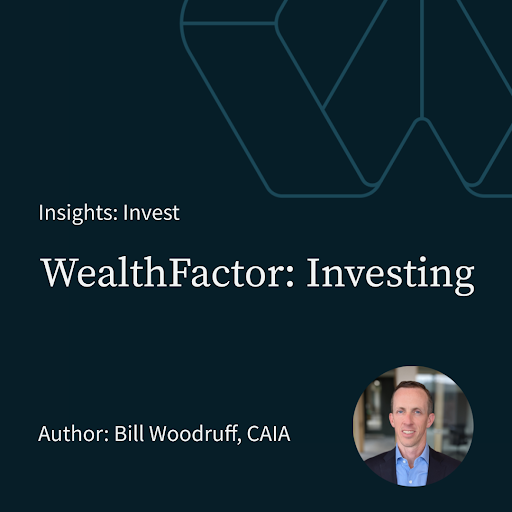May 2020 Review Replay
SUMMARY KEYWORDS
prices, fixed income, portfolios, risk, markets, equities, investors, corporates, year, investment, earnings, yields, dramatically, quarter, point, bonds, graph, investing, clients, stocks
00:00
And that with me, so just a few comments for compliance purposes. This call is for informational purposes only and maybe recorded statements made during this call, or the opinions of the speaker and are subject to risks and uncertainties, some of which are significant in scope. And by their very nature. Beyond the control of wealth factor, there can be no assurance that such statements will prove to be accurate. And actual results in future events could differ in a material way from set statements. Historical results are not necessarily indicative of future performance. So I'll just as a quick note of background for those of you who've joined to may be less familiar with me, my name is Bill Woodruff. I founded well factor in 2017. And I'm responsible for all investment activity well factor. I've been in Investing for over 20 years now and have a diverse background of mostly building and managing portfolios for other investment professionals. Wealth factor is a Lake Oswego based investment advisor. What we do is build custom investment plans for each of our clients and offer that through an investment advice service. Our we build portfolios that are customized per client, but generally based on indices and mostly comprised of stocks, and or bonds. Accounts are held in clients names at independent third party custodians. We charge a point three to 5% fee on assets up to 10 million and then point 1% on assets over Nyan.
02:03
Just a quick note about the composition philosophically for how I approach, investing and building portfolios of its philosophy is called risk smart. And there are three core components to that. Being portfolio smart, which is a reference to the structure, and largely about what investors should avoid. It's my belief they should generally avoid things like attempting to pick securities and time markets, they should avoid layers, and they should avoid complexity. fee smart. It's my belief that high fees, forces investment advisors to take on unnecessary risks in portfolios. And the last element in risk smart is the tax smart. And this is a something that I see that's often overlooked. But at the end of the day after tax results are really what matters most. So it's, as I dive into and talk about the prior month, you know, it's important to contrast my intention for this monthly update to what you might Terry stereotypically expect. From a call like this. I won't be spending a lot of time on specific details and these sorts of calls. I philosophically believe that those that get really focused on on what's going on in the short run are put themselves into positions where they're likely to make structural or investment oriented mistakes that will inhibit them from capturing the returns that markets can provide. So I'll start I'm going to provide us an overview of April's update. So this is actually a slide used last month. But it's really still relevant in terms of the elements. And so there's a lot of there has been really sense the bottoming out for risk assets, including equity prices in March with the idea that this doesn't make sense of the we're going to there's going to be a recession, earnings are going to go down, why are prices going up? And so in April's update, we covered a variety of those elements. And you know, many of these elements are still true. I think it's important to always remember that the stock market doesn't represent the what might happen in the next day or two. It really represents current pricing really represents the markets attempt to value companies and it's it does it does a nice job thinking about that out, typically somewhere between, let's say, six months and three years. And that's the challenging part in terms of for those that think that they might be able to try to time markets is you really never know. You know what that timeframe is? The thing that I believe that and I think why there's an opportunity for those that have take take a disciplined approach to investing is I think, while the market has the potential to
05:32
do a nice job of factoring in what might be happening over the next three years, you know, that's really the extent of the average investors time horizon. And I believe that stocks and other risk assets
05:46
should be looked at with an investor's lens and more like a 10 year or longer time horizon. And I think that there's going to persistently the opportunity to generate return, you know, perhaps There's a little bit of US based optimism and how I think about the world and maybe humanity a little bit too, in terms of, you know, continued, you know, will we continue to just to innovate? Will there be businesses? Will businesses continue to exist? And will they continue to provide goods and services to individuals and other companies and I have that optimism and I think as long as it holds true, you know, we will continue to see risky or investments or maybe more specifically, diversified portfolios of equities outperform safer and perhaps less stable investment choices like cash and higher quality, fixed income. So today, I'm going to cover today, Tim, and I try to keep it pretty brief. You know, a lot of themes that I that happened during the month that if we try to ignore The detail in the noise dramatically again, there's a lot of overlap to April. And so I'm going to spend a little time talking about the longer term context, which I think makes it easier to appreciate why we've seen equity prices go up so dramatically. I like to look at and and stay and stay aware of the divergences that you see in performance from a size and style perspective. I've done a fair amount of research on the topic and, and believe that it's easy for investors to get
07:38
overly focused on what did well yesterday or the last couple of years. But you know that the time and energy I've spent on that topic would suggest that over longer term cycles, you know, the next 10 years might be a very different group of stocks that provide a strong returns versus the last 10 years, and then I'll spend some time talking Talking about interest rates in fixed income. And I think that's an important element. Because you know, whether your portfolio includes fixed income or not even depending on whether that makes sense for from a stage or risk profile perspective, I think as I build portfolios, it's always a process of trying to think through the relative risks versus the return opportunity and fixed income right now in any reasonable amount of quality and then even in to some degree, lower quality, fixed income. You know, yields have really gone very, very low. And that's a supportive element for higher valuations for equities and higher prices for equities, as investors have dollars and they have to go somewhere. And you know, cash is clearly a choice but with an interest rate of zero. You know, cash probably continues to be A choice that could be, you know, relative to other things over a reasonable period of time, a pretty painful place to be. In, there's a few graphs that if you participate in
09:15
my presentations like this, you'll see frequently. And so you know this, what this graph is, is it goes back to the 1900s, and looks at US equities prices. And so you know, it puts the units in a log scale, which allows the visual change in the early part of the graph to appear, at least from a scale perspective, similar to today, if you didn't do this, if you didn't put in a log format, it would look like an incredible hockey stick or it's, it's flattened, and it just ramps up dramatically. So log scales really the only way to look at data going this far back. So you know, the point here is that it's so easy to get focused on What's happening today and what's happening this year last year, but if we look at this, the this downward movement in prices that we saw in the first quarter, you know, you can draw between both sides of the conclusion that one it wasn't nearly as bad as it perhaps could have been. But I think the better conclusion is, you know, these sorts of things are just part of markets. And, you know, what we really need to do is work very hard on not allowing these things to affect how we, we invest, and stay disciplined to, you know, really a target set of exposures or, you know, some sort of investment plan. You know, as I as I think about the process I went through so far this year, you know, I had a lot of newer clients over the prior let's call it nine months, who are You know, the potential reward relative to risks didn't feel great. And so oftentimes what I was doing was creating investment plans where if markets decline, then buys occurred. And a lot of the fixed income exposures that I had built for clients were very tilted towards treasuries, or the highest quality, fixed income, and with the hope that at some point be compensation for taking more credit risk would emerge, and a lot of that played out in the first quarter. And so then I'll let me share a quick graph here. So this graph is the s&p 500 over the last 12 months. And so, you know, a lot of just to put a little bit of perspective on the you know, very fast decline, not not unlike, say, the severity, although the duration is longer than a 1987 sort of the climb and you know, we Really are seeing a V shaped price recovery as you look at it over this sort of timeframe. And so, you know, this sort of thing is, as you know, I perhaps try to deal with the practical challenges of putting investor dollars to work and wanting to balance risk and reward. You know, as prices decline and compensation for risk look a lot better. There was a lot of activity in terms of investing more into stocks in the first quarter, and then taking on additional credit risk. And at that time, if those those decisions weren't based on the idea or some sort of forecasting or belief that there would be a V shaped recovery. It's, it's, as I approached this, it's always I don't know what's going to happen in the short run. But these are, you know, I'm now being compensated for my risk, relative to each client's specific capabilities and to do Do that risk. And so what's largely happened for you know, as I navigate this is, as prices, recover across all sorts of risk types, both equities, as well as
13:14
bonds of lesser quality. And I'll say it that way, because it's absolutely a spectrum from, let's say, an apple bond to, you know, some sort of junk junk rated bond, as all of those have recovered in price just like stocks. I've been proactively reducing and scaling those sorts of risks back that were added in the first quarter. So, you know, I my philosophical preferences and to be active, but at the same time, you know, I think it's not hard to conclude that 40% decline 42 in some cases, 80% declines and assets is probably irrational, and to the extent that we, you know, you hadn't been exposed to certain risks in advance of those price declines, now might have been a pretty good time to take those on. You know, I think that's, that's the hard part for investing is the timing and doing that is the point in which you're going to feel about as uncomfortable as you'll ever feel as an investor. So, you know, I think that as I advocate for having a advisor who can maintain a lack of emotion through the process, I think that's where, you know, hopefully I can add a little bit of value for clients.
14:40
Okay, so back to the slides here. Okay, so real quickly, you know, talking about that divergence of style and size and so you know what, at the, the these measurements, there's no perfect science behind it. But you know, size of company and then, you know, growth companies, those companies that might not have the same sort of valuations might be growing revenue really fast versus a value company where there might be really attractive valuations but perhaps aren't growing as fast or at all. You know, one thing I'll highlight in here before I talk about the divergence in performance between style and size, is that in this page versus the last month's set of data, what you'll see is the valuations don't look very good. And that's a function of market prices, rebounding dramatically, and earnings going down because of the restrictions or economic activity. So, you know, if we, if we go back to my prior point in that prices are going up based on an optimism that the earnings over the next level Say three years won't be as dramatically impacted as people might have thought 45 days ago. Yeah, the PE as a major evaluation is looking at what the earnings are right now. So we see price going up based on optimism that earnings over the next three years it will be okay or better than feared 45 days ago. Yep. The earnings part of it is clearly impacted because of all of the restrictions and operating businesses providing services and providing goods. And so so then looking at the some of the dispersions You know, there's there's been a decade long outperformance by large growth. And we continue to see that relative to value and relative to smaller companies so strongly that large growth is actually up on a year to date basis. If we look at on a quarter day basis,
17:00
Those sorts of things are still persisting. And I did see in the last week or two, which, again, anytime I bring up any anything from a reference perspective, it's not to suggest that there's a trend or one can predict these sorts of things. But in the last week or two, we did see a meaningful reversion in some of these environments where small value did really quite well, relative to specifically mega large growth with a tech orientation to that. So, you know, I think there's just at some point valuations do matter. And so, you know, that's and that will matter over time. The thing that we're why valuations aren't the end all be all is we can't predict what the earnings of any one specific company, industry, or sector is going to be. And so it's entirely possible That mega cap tech just continues to grow its earnings at a far faster pace and revenue far faster pace than everything else and its performance is the best. So you know, that's that's likely case for diversification. So let's transition now to some thoughts on fixed income in general, so fixed income for a moment, I thought was going to get easier. But what ended up happening is, you know, as the opportunity in credit markets, opened up the prep because of falling prices. We've seen an incredible snapback and those prices, you know, and that's in two different areas. investment grade credit, where the government came in and said, we're going to, you know, support this market and so there was a near full snapback in price and then even non investment grade companies or crowd use or credit sorry for the vernacular. can't shake my shake my roots without one. But so the non investment grade or lesser quality bonds have appreciated dramatically from their lows, just like stocks, and perhaps still, you know, for those that have the tax profile and risk profile and really need income, you know, they probably still look reasonably interesting, especially relative to they were where they were at the begin of the year. But for me, it's,
19:30
you know, that's a bit of a stretch given. What we've seen is incredible decrease in yields and compensation for what I think is going to be on a going forward basis, a really significant amount of risk in the short run and potential for defaults and in those sorts of companies. So this graph here is the yield curve for US Treasuries, and the dotted line is looking back to December, end of year two 2013 and so what you can see, and at that time, you know, coming out of the financial crisis, we ensure that the Fed was being very accommodative for its rates, but the market rates for really an anticipation of what ended up being a period of strong economic growth and activity, the market there was a steepness to that yield curve, where as you went out and owned higher, longer maturity, bonds, you've got quite a bit more yield. Well, in today's environment is that is right back to that accommodative state where the very short end three months is that starting point on the graph is near zero yield. What we've seen is an incredible flattening, and as of the end of May, the 30 year Treasury had a yield of only 1.4% and making for a very difficult environment for safe, fixed income or safe Investing in general and that's by
21:02
design, you know, now's the the Fed wants to force or at least at a minimum incentivize investors in aggregate to go out and take risks and, and create economic activity. The fixed income is fought, as I alluded to is far more than just the treasuries. And so this is, these are some data points here for the end of the quarter and end of May. So corporates in general. So the challenge in using just a corporate
21:41
a single data point for corporate is this is showing an average maturity of 12 years. Well, this index likely encompasses bonds from with one year of maturity out to, you know, far farther than 12 years. And so, but it gives us a data point and shows us that you know, yields while Treasury yields And let's use the 10 year as a relatively close comparative, all Treasury yields over the quarter haven't necessarily gone in any material way. We've seen corporates fall dramatically. And so what that effectively says is, these are as it as risky as people felt at that time, and they're not requiring as much yield to invest in them. If we look at that the spread or the difference between corporates and treasuries, it's still fairly wide, or investors are still getting a fair amount of compensation for that credit risk, at least relative to what we saw at the beginning of this year, but far less than at the end of
22:46
of the prior quarter of the first quarter of the year. And so as a reminder, as yields all bond prices go up, and so investments in corporates at the end of March, we've seen An incredible increase in price. And consistent with my earlier comments, in many cases where risk was scaled up in the first quarter and then some someone was conservative portfolios. What that meant was a shift from treasuries to investment grade corporates, a lot of the investment grade corporate position to some of it has been removed out of portfolios because of how fast that reversion occurred and Vshape price recovery.










